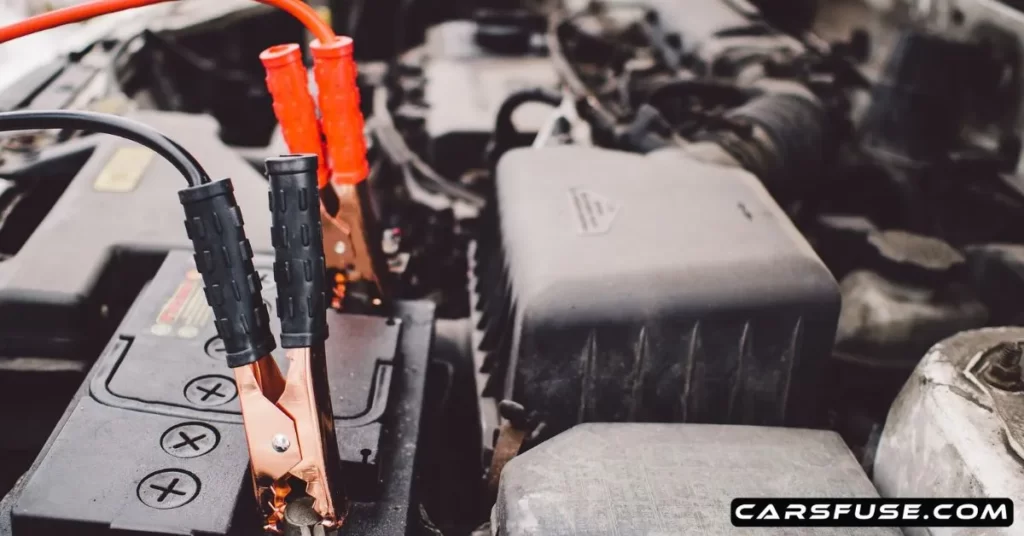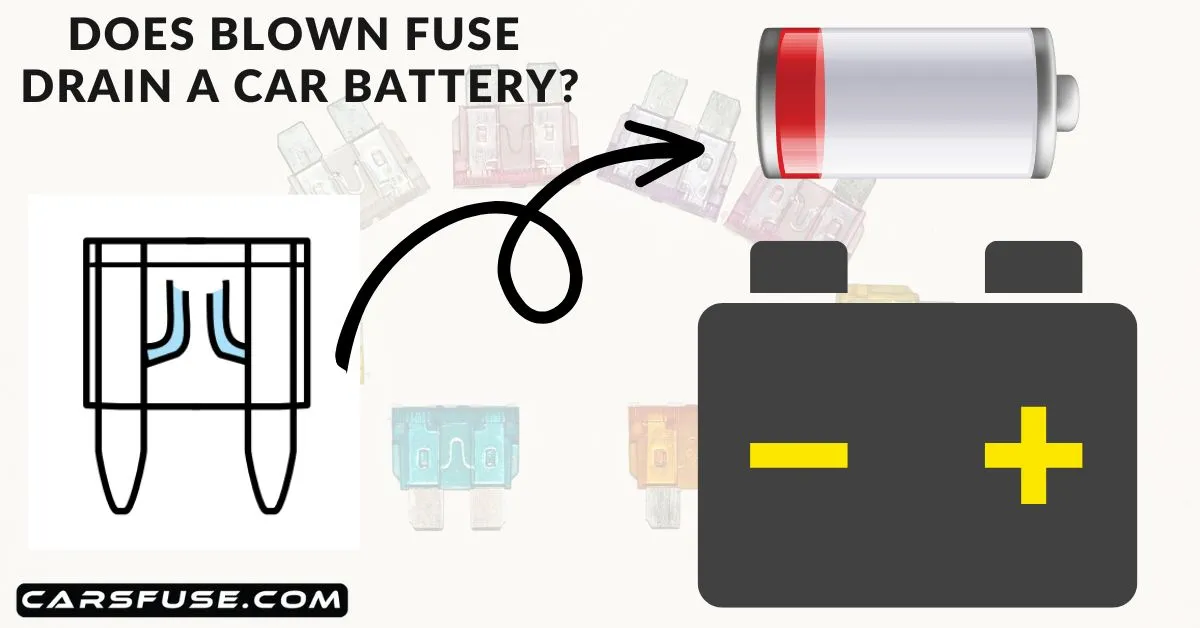One of the common questions vehicle owners keep on asking is ‘Can a blown fuse drain a car battery?’.
The various electrical components of a vehicle are protected by the fuses located in the fuse box or panel. The fuse box also includes fuses for the vehicle battery which provides the initial power required to start the engine and supply electricity to the components.
In this informative blog, we will find out if a blown fuse drains a car battery or not. We will explore the role of fuses in the vehicle’s electrical system, and also see a real example.
Let’s get started with a basic understanding of car fuses.
Table of Contents
Importance of Car Fuses
Car fuses are an integral part of a vehicle designed to protect electrical circuits. Fuses are the small devices found in the vehicle’s fuse box located in the engine compartment or the interior section.
Fuses are designed to melt, and break the circuit when an excessive electrical current flows through them or there is an event of electric short circuit.
There are various types of fuses in a car such as blade fuses, cartridge fuses, and mini-blade fuses. Every fuse has its own specifications and functions.
Regarding the battery, there are fuses for preventing damage to the battery system.
How fuses can affect the battery in a car? Does it drain the battery?
A faulty or blown fuse doesn’t directly drain the car battery. There might be various other reasons for draining your car battery.
When a fuse blows out due to reasons like overloading, it cuts the flow of electricity to the connected components. This is because the role of a fuse is to protect vital electrical components such as interior lights, power windows, infotainment systems, electrical accessories, starter motors, and so on.

If you are worried about draining your car battery due to blown fuses, it is important to note that a blown fuse does not directly drain the car battery.
When a fuse blows, it severs the circuit and prevents power from reaching the affected component. However, the car battery itself does not drain due to a blown fuse.
It is more likely that other factors, such as prolonged use of electrical components, a faulty alternator, parasitic battery drain, or a weak battery, contribute to the battery drainage.
Therefore, it is crucial to consider these factors when diagnosing battery issues rather than solely focusing on blown fuses.
Let’s look at the fuses of the 2023 Ford F250 Super Duty Pickup truck.
2023 Ford F250 Under Hood Fuse Box Details
| Item | Rating | Protected Component |
| 1 | 50 A | Cooling fan 1. |
| 2 | 50 A | Heater. |
| 3 | 50 A | Heater. |
| 4 | 50 A | Heater. |
| 9 | 30 A | Four-wheel drive module. |
| 10 | 30 A | Compressed natural gas module switch. |
| 12 | 60 A | Anti-lock brake system pump. |
| 13 | 30 A | Passenger power seat. |
| 14 | 40 A | Anti-lock brake system valve. |
| 15 | 30 A | Body control module RP2 bus. |
| 21 | 10 A | Trailer tow backup lamps. |
| 22 | 10 A | Four-wheel drive system. |
| 23 | 20 A | Vehicle power 1. |
| 24 | 20 A | Vehicle power 2 (gas). |
| 10 A | Vehicle power 2 (diesel). | |
| 25 | 15 A | Vehicle power 3 (gas). |
| 10 A | Vehicle power 3 (diesel). | |
| 26 | 20 A | Vehicle power 4. |
| 27 | 10 A | Vehicle power 5 (gas). |
| 20 A | Vehicle power 5 (diesel). | |
| 29 | 15 A | Diesel exhaust fluid tank heater. |
| 30 | 15 A | Diesel exhaust fluid line heater. |
| 31 | 15 A | Glow plug and dosing module. |
| 34 | 20 A | Rear heated seats. |
| 36 | 30 A | Electronic power assists steering. |
| 37 | 5 A | 24 V alternator. |
| 38 | 10 A | Powertrain control module. Transmission control module. |
| 39 | 10 A | Anti-lock brake system. |
| 40 | 10 A | Electronic power assist steering. |
| 41 | 10 A | Blind spot information system. Trailer tow tire pressure monitoring system. Rear electronic module controller area network. |
| 42 | 10 A | Snowplow. |
| 43 | 15 A | Interior power distribution box run/start. |
| 45 | 15 A | Heated steering wheel. |
| 46 | 20 A | Not used (spare). |
| 47 | 5 A | Not used (spare). |
| 48 | 30 A | Amplifier. |
| 49 | 25 A | Not used (spare). |
| 51 | 40 A | Blower motor. |
| 52 | — | Not used. |
| 53 | 10 A | Four-wheel drive – transfer case control module. |
| 54 | 10 A | Not used (spare). |
| 55 | 10 A | Not used (spare). |
| 56 | 40 A | Electronic power assist steering. |
| 57 | 20 A | Trailer tow lighting module. |
| 58 | 50 A | Customer interface module. |
| 59 | 60 A | Inverter. |
| 60 | 60 A | Interior power distribution box B+. |
| 61 | 30 A | Vehicle battery 2. |
| 62 | 5 A | Smart trailer hitch. |
| 63 | 10 A | Smart data link connector. Enhanced central gateway. |
| 64 | 5 A | Glow plug relay coil (diesel). |
| 65 | 10 A | Compressed natural gas module power. |
| 74 | 30 A | Trailer brake control. Aftermarket e-brake access. |
| 75 | 30 A | Compressed natural gas powered at all times. |
| 76 | 25 A | Trailer tow lighting module battery charge. |
| 77 | 30 A | Vehicle battery 1. |
| 78 | 20 A | Power point 2. |
| 79 | 20 A | Power point 1. |
| 84 | 20 A | Horn. |
| 85 | 40 A | Heated rear windshield. |
| 91 | 5 A | Headlamp control module. |
| 92 | 15 A | Left-hand headlamp. |
| 93 | 15 A | Right-hand headlamp. |
| 94 | 20 A | Power point 3. |
| 95 | 20 A | Power point 4. Smart charge module. |
| 98 | 10 A | Tailgate release. |
| 101 | 50 A | Customer interface module. |
| 102 | 5 A | Rain sensor. |
| 103 | 30 A | Front wiper motor. |
| 105 | 30 A | Fuel pump. |
| 106 | 30 A | Body control module RP1 bus. |
| 107 | 25 A | Trailer tow park lamps. |
| 108 | 40 A | Driver power seat. |
| 109 | 30 A | Starter motor. |
| 111 | 30 A | Power sliding rear window. |
As you observe the Under Hood fuse box table of the 2023 F250 truck, you can see the Vehicle battery fuses (items no. 61, and 77). These fuses are responsible to protect the main supply circuit from loads.
Fuses for the car battery protect the electrical circuits connected to the battery. Not only that, but the fuses also protect the car battery.
If the fuses associated with the car battery blow, the electric circuit breaks preventing further damage to the electric components.
Battery drainage can occur due to various other reasons listed below.
- Parasitic battery drain due to faulty wiring, and malfunctioning modules.
- Faulty Alternator not generating enough power.
- Aging or Weak Battery
- Corroded Battery Terminals
- Extended Periods of Inactivity
- Exposure to extreme temperatures
- Excessive Electric Load
Conclusion on ‘Can a blown fuse drain a car battery?’
In conclusion, blown fuses play a vital role in protecting the electrical components of a car’s system. While they can cause disruptions and render specific electrical systems inoperable, they do not directly drain the car battery. When a fuse blows, it simply interrupts the circuit, preventing power from reaching the affected component.
Various causes can contribute to a drained car battery, such as parasitic battery drain, a faulty alternator, an aging or weak battery, or corroded battery terminals. These factors should be thoroughly examined to pinpoint the source of the battery drainage accurately.
By understanding the role of fuses, identifying potential causes of battery drainage, and implementing preventive measures, car owners can ensure the longevity of their batteries and enjoy an uninterrupted performance from their electrical systems.
Remember, addressing both blown fuses and battery drainage is crucial for maintaining a reliable and efficient car electrical system.
Tom Smith is a passionate car mechanic and automotive enthusiast, specializing in the intricate world of car fuse boxes. With years of hands-on experience under the hood, he has earned a reputation as a reliable expert in his field. As the founder and content creator of the popular blog website 'carsfuse.com,' Tom has dedicated himself to sharing his extensive knowledge of car fuse boxes and electrical systems with the world.

